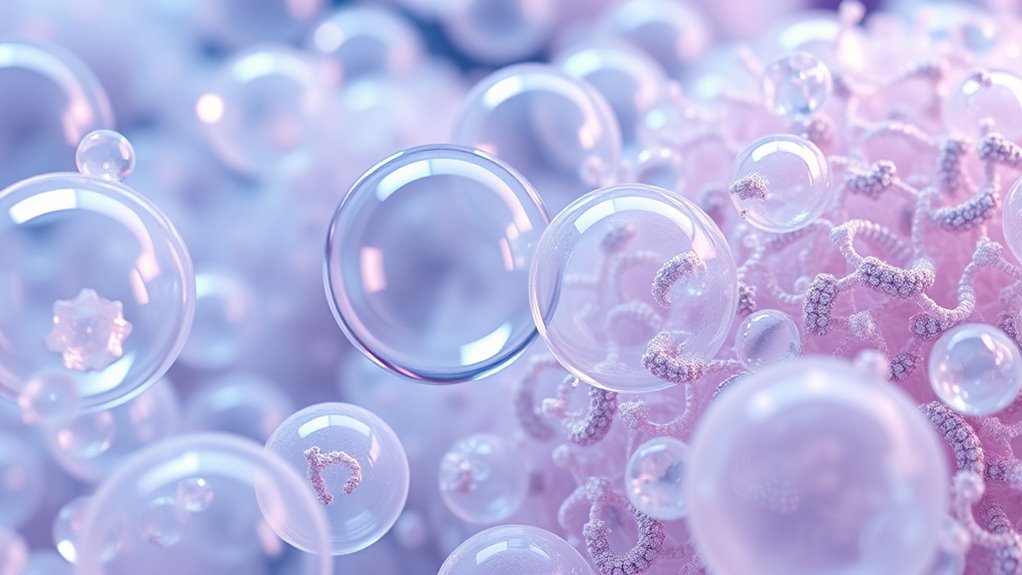Drug delivery nanocarriers like liposomes, micelles, and exosomes help improve treatment by targeting drugs directly to affected areas while reducing side effects. Liposomes are versatile and biocompatible, while micelles excel at carrying poorly soluble drugs. Exosomes are natural vesicles with inherent targeting abilities and low immune response. Understanding their structures and uses can enhance therapy effectiveness; exploring further reveals how these systems are shaping future medicine.
Key Takeaways
- Liposomes are lipid bilayer vesicles capable of encapsulating hydrophilic and lipophilic drugs, used for targeted therapy and vaccines.
- Micelles are self-assembled amphiphilic structures with hydrophobic cores suitable for delivering poorly soluble drugs.
- Exosomes are natural nanovesicles with low immunogenicity, engineered for specific cell targeting and delivery of biomolecules.
- Nanocarriers enhance drug stability, control release, improve targeting, and reduce systemic toxicity in various therapeutic applications.
- Challenges include stability issues, immune responses, scalability, and regulatory hurdles, guiding ongoing research and development.
Overview of Nanocarrier Types in Drug Delivery
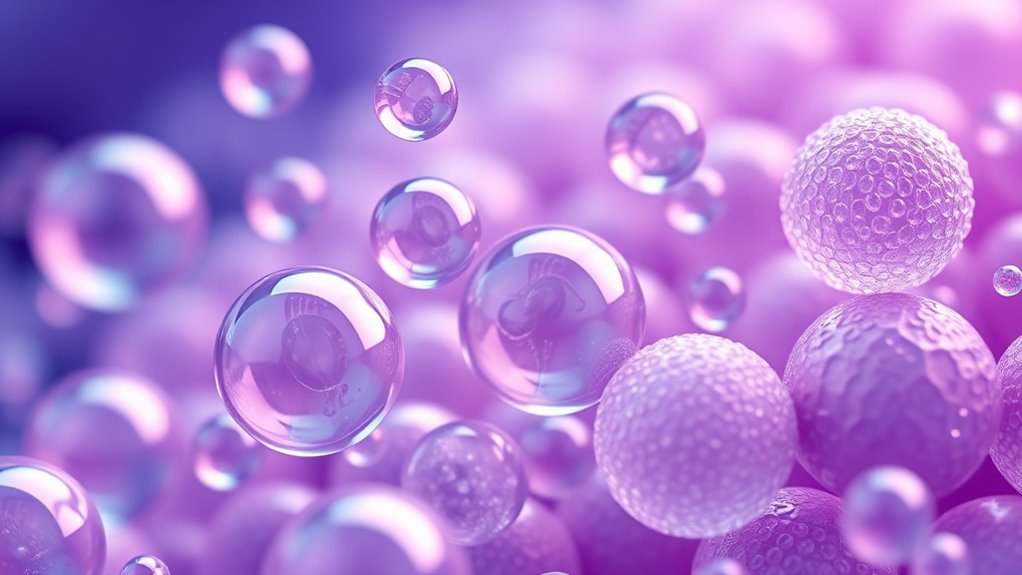
Nanocarriers are specialized delivery systems designed to improve the targeting and efficiency of drugs within the body. You can choose from various types, each with unique features.
Micelles are nanoscale structures formed by self-assembly of amphiphilic molecules, creating a hydrophobic core for encapsulating poorly soluble drugs. They enhance drug solubility, stability, and allow controlled release by modifying their surface.
Exosomes are natural vesicles derived from cells that carry proteins, lipids, and nucleic acids, offering excellent biocompatibility and the ability to cross barriers like the blood-brain barrier. Color accuracy impacts overall image quality, and is an important consideration in designing effective nanocarrier systems for drug delivery.
Polymeric nanocarriers consist of biodegradable polymers that protect drugs and enable sustained release.
Solid lipid nanoparticles combine benefits of liposomes and polymers, providing stability, controlled release, and low toxicity.
Each type supports targeted delivery and improved pharmacokinetics.
Understanding Liposomes and Their Role in Medicine
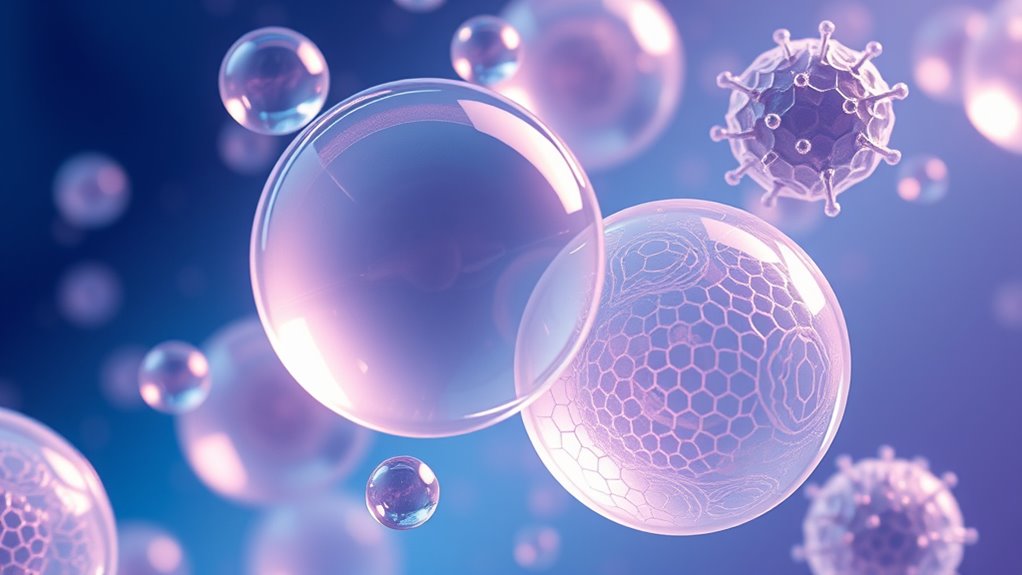
Liposomes stand out as highly versatile nanocarriers in medicine due to their unique structure and adaptable properties. Their lipid bilayer allows them to encapsulate both water-soluble and lipid-soluble drugs, making them suitable for various therapies. Research into local tips can help optimize their design and application for specific medical needs. You can produce liposomes with different lipid compositions, influencing their stability, drug release, and compatibility. During formation, passing a lipid suspension through membranes with fixed pore sizes ensures uniformity, which is critical for consistent drug delivery. Liposomes can be tailored for targeted delivery, either passively or actively, by modifying their surface with ligands or antibodies. They protect drugs from degradation, extend their half-life, and enable controlled release. Their biocompatibility minimizes adverse reactions, making liposomes a promising tool for cancer therapy, vaccines, antibiotics, and gene delivery. Additionally, the use of targeted delivery strategies can further enhance treatment efficacy and reduce side effects.
The Structure and Applications of Micelles
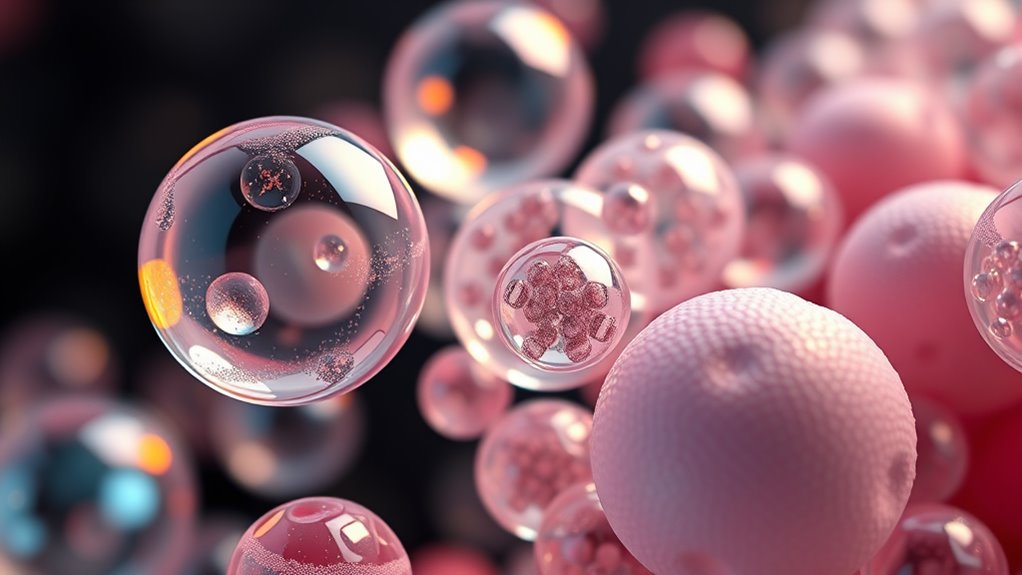
Micelles are spherical structures formed by the self-assembly of amphiphilic molecules, featuring a hydrophobic core surrounded by a hydrophilic shell. This core serves as a reservoir for loading poorly soluble drugs, while the shell stabilizes the micelle in aqueous environments and offers steric protection.
Typically, micelles are nano-sized and made from block copolymers, mimicking biological transport systems for enhanced delivery. Their stability depends on the critical micelle concentration (CMC); lower CMC values mean higher stability in the bloodstream.
To prevent premature dissociation, strategies like core or shell crosslinking and stimuli-responsive polymers are employed. Micelles excel at encapsulating hydrophobic drugs, improving bioavailability, and enabling controlled release—making them valuable in targeting cancer, inflammation, and other chronic diseases.
Exploring Exosomes as Natural Drug Carriers
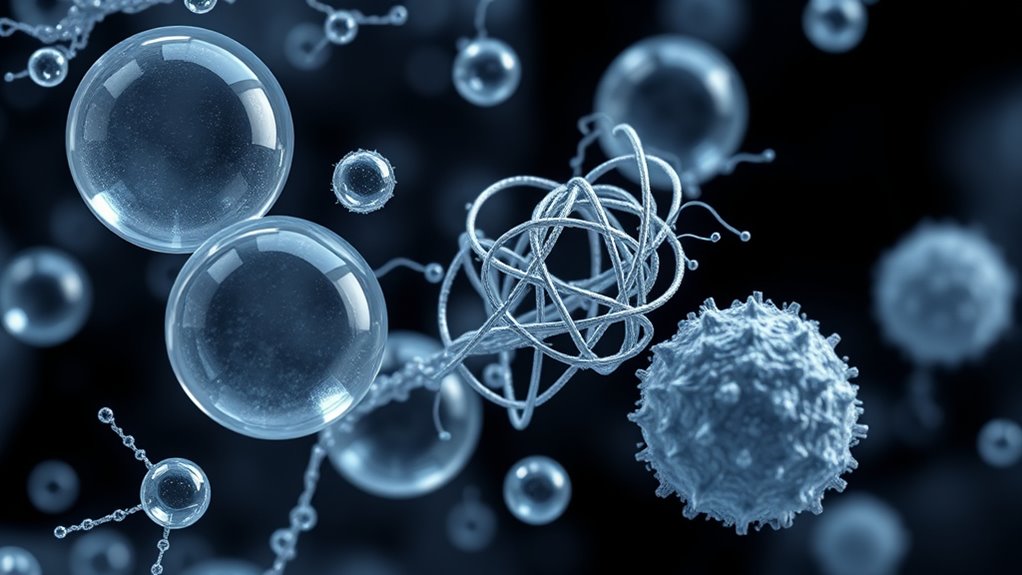
Building on the concept of engineered nanostructures for drug delivery, exosomes emerge as a promising natural alternative. These small vesicles (40–160 nm) are secreted by cells and found in biological fluids. Composed of lipids, proteins, and nucleic acids, they naturally facilitate cell-cell communication. Lucid dreaming techniques can be adapted to enhance understanding of cellular communication pathways, which is relevant for designing targeted therapies. Additionally, advances in exosome isolation methods are improving the purity and yield of these vesicles for research and therapeutic applications. Their low immunogenicity, high biocompatibility, and stability make them ideal for therapeutic use. Exosomes can be engineered to include targeting molecules, enhancing delivery to specific cells like cancer or nerve cells. They also protect drugs from degradation, extending circulation time. Biocompatibility is a key advantage that supports their use in various clinical settings. Techniques such as surface modification and genetic engineering enable precise drug loading and targeting. Despite challenges in scalability and regulation, exosomes hold significant potential as natural nanocarriers for diverse therapies, combining biological compatibility with customizable features.
Benefits of Using Nanocarriers in Therapeutics
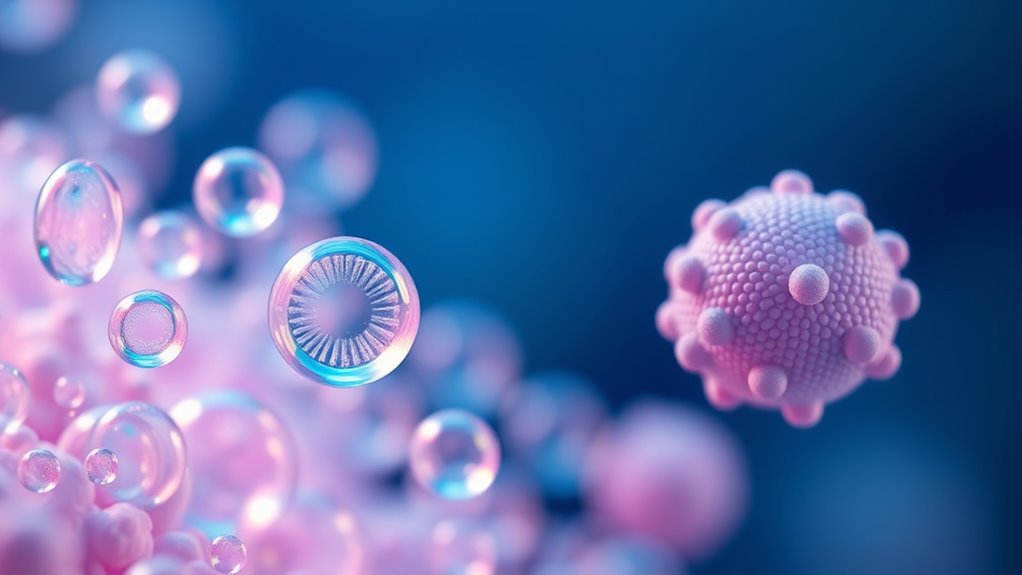
Nanocarriers markedly enhance therapeutic efficiency by directing drugs precisely to target sites, increasing local concentrations and improving treatment outcomes. Their high surface area enables modification of drug properties, boosting bioavailability, solubility, and stability.
Encapsulation protects labile drugs from degradation, ensuring they remain effective longer. Controlled, sustained release maintains therapeutic levels and reduces dosing frequency. Targeted delivery systems further optimize treatment by ensuring drugs act specifically where needed, reducing side effects.
By minimizing off-target exposure, nanocarriers lower systemic toxicity, making potent drugs safer. Functionalization with ligands allows active targeting, directing therapies specifically to diseased cells, which enhances efficacy and reduces side effects.
Their customizable properties—size, shape, surface charge—allow adaptation to diverse therapeutics and stimuli-responsive release. Additionally, eye patch benefits such as hydration and anti-aging effects demonstrate the importance of targeted, skin-specific delivery systems in improving overall health and appearance. Advances in nanotechnology enable precise control over nanocarrier design, tailoring their behavior to meet specific medical needs. Overall, nanocarriers offer improved pharmacokinetics, greater precision, and enhanced safety, revolutionizing drug delivery in modern medicine.
Challenges in Developing Liposome-Based Treatments
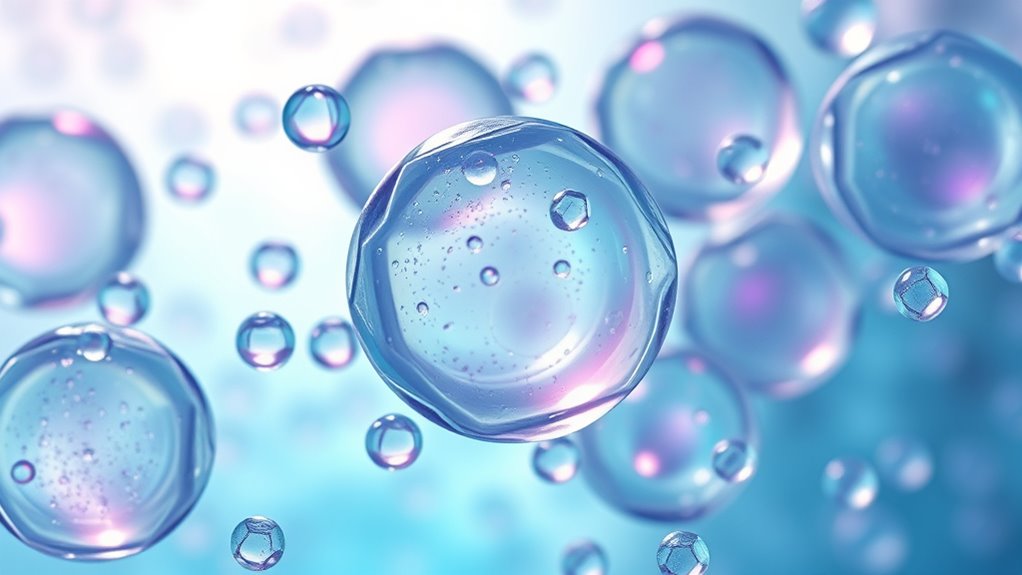
Developing liposome-based treatments faces numerous challenges that hinder their full clinical potential. Immunologically, liposome components can provoke immune responses, making repeated dosing problematic. PEGylated liposomes may trigger “accelerated blood clearance,” reducing circulation time and effectiveness, while antibody production can limit their utility. These immune reactions, observed in animals and likely humans, impair evasion from clearance mechanisms. Additionally, understanding ethical hacking principles can inform the development of secure drug delivery systems resistant to malicious interference.
Chemically and physically, liposomes often struggle with stability issues—leading to premature drug leakage, compromised storage, and inconsistent manufacturing. Achieving uniform size and integrity remains difficult, shortening shelf life. Additionally, balancing stable drug encapsulation with efficient release at target sites is complex.
Tumor heterogeneity, microenvironment barriers, and intracellular obstacles like mitochondrial membranes further complicate targeted delivery and internalization, hampering treatment efficacy.
Advantages of Micelle Systems for Hydrophobic Drugs

Micelle systems offer a compelling solution for the delivery of hydrophobic drugs by effectively solubilizing them within their core. This enhances bioavailability by protecting drugs from metabolic degradation and maintaining their stability in circulation.
Encapsulation reduces systemic toxicity and side effects by limiting drug exposure to non-target tissues. Their stable core-shell structure, formed by amphiphilic copolymers, ensures high stability even when diluted in biological environments.
Micelles naturally accumulate in tumor tissues through the EPR effect and have prolonged circulation times, improving targeting efficiency. Made from biocompatible and biodegradable materials, they support safe administration and controlled drug release.
Their ease of scale-up and ability to be tailored for active targeting make micelle systems versatile tools for hydrophobic drug delivery.
The Potential of Exosomes in Targeted Therapy
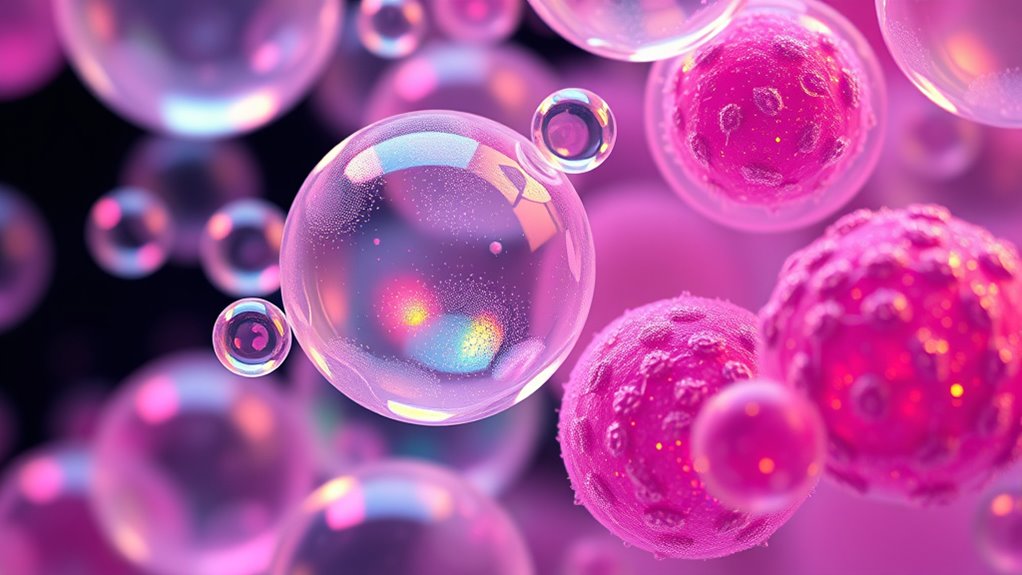
Have you ever wondered how natural cellular communication can be harnessed for targeted therapy? Exosomes naturally display cell-origin dependent biodistribution, making them excellent carriers. Tumor-derived exosomes have surface proteins that give them an innate affinity for tumor microenvironments and metastatic sites. This natural targeting reduces off-target effects but needs enhancement for clinical precision.
Engineering strategies, like genetic modification and chemical conjugation, enable attaching ligands or antibodies to improve cell-specific binding and tissue targeting. These modifications help overcome natural limitations, such as rapid clearance and non-selective distribution.
Exosomes can carry diverse biomolecules—DNA, RNA, proteins—which makes them versatile in delivering therapeutics. Their ability to naturally home to specific tissues, especially tumors, presents a promising approach for targeted therapy, with ongoing efforts to optimize their safety and efficacy.
Current Limitations and Future Directions for Nanocarriers

Despite the promising potential of nanocarriers in targeted drug delivery, several limitations hinder their clinical application. Variability in vascular permeability often restricts nanocarrier penetration into tumor tissues, leading to suboptimal delivery.
Stability issues, like aggregation, can cause premature drug release before reaching the target site. Many nanocarriers also struggle with low drug loading capacity, especially for high-dose therapies.
Regulatory challenges add complexity, as standards for approval are still evolving, and safety data requirements are extensive. Toxicity concerns demand thorough evaluation, prolonging development timelines.
Future directions include integrating artificial intelligence to optimize design, developing advanced materials for better stability and loading, and customizing nanocarriers for personalized medicine.
Improving targeting mechanisms and standardizing manufacturing processes will also be essential for clinical success.
Comparing Liposomes, Micelles, and Exosomes in Clinical Use
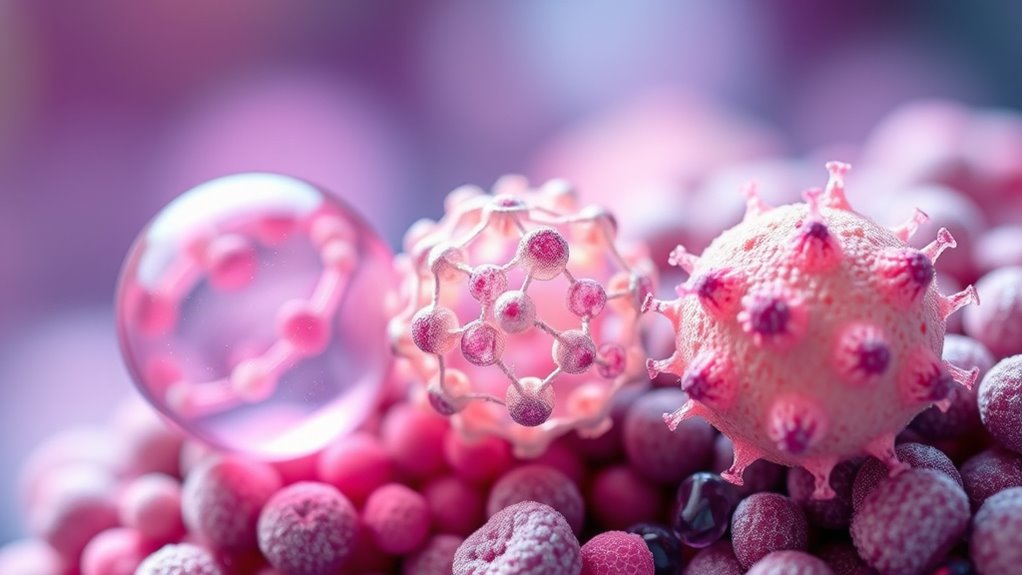
When comparing liposomes, micelles, and exosomes in clinical use, it’s important to take into account their distinct compositions and structural features.
Liposomes are synthetic vesicles made of phospholipid bilayers, lacking cellular proteins or nucleic acids, and are well-established in drug delivery, especially in cancer therapy.
Micelles are formed by amphiphilic molecules with a hydrophobic core, ideal for solubilizing hydrophobic drugs, but they’ve shorter circulation times.
Exosomes are natural vesicles containing lipids, proteins, and nucleic acids, offering inherent targeting and immunomodulatory advantages.
While liposomes are widely approved and customizable, exosomes’ biological complexity can hinder scalability.
Liposomes are more scalable than the biologically complex exosomes.
Micelles excel in drug solubilization but face stability issues.
Hybrid carriers are emerging to combine the best features of these nanocarriers.
Frequently Asked Questions
How Do Nanocarriers Cross Biological Barriers Effectively?
You want to know how nanocarriers cross biological barriers effectively. They do this by leveraging different transport mechanisms like passive diffusion for small, lipophilic particles, or receptor-mediated and transcytosis pathways that involve specific ligand-receptor interactions.
Optimizing size, surface chemistry, and material composition enhances their ability to navigate barriers such as the BBB or tumor vasculature. These strategies help nanocarriers reach their target sites efficiently and safely.
What Are the Regulatory Considerations for Nanocarrier-Based Drugs?
Oh, steering regulatory waters with nanocarrier drugs is a breeze, right? In reality, you must guarantee rigorous quality, safety, and efficacy assessments, focusing on properties like size, charge, and stability.
You’ll need to comply with evolving guidelines, conduct in vitro and in vivo tests, and address unique nanomaterial challenges. Balancing innovation with safety, you’ll face international harmonization efforts and ethical considerations, all aimed at protecting patient health while fostering technological progress.
Can Nanocarriers Be Personalized for Individual Patients?
You can definitely personalize nanocarriers for individual patients. By customizing their structures and surface modifications, you guarantee targeted delivery based on each person’s disease profile, genetics, and microenvironment.
Adjusting drug release, biocompatibility, and administration routes helps optimize safety and efficacy.
Functionalizing nanocarriers with specific ligands or targeting molecules allows you to deliver therapies precisely where needed, making personalized treatment more effective and minimizing side effects.
How Scalable Are Current Manufacturing Methods for Nanocarriers?
You’re wondering how scalable current nanocarrier manufacturing truly is—well, buckle up. With techniques like microfluidics and high-pressure homogenization, there’s potential, but they demand hefty investments and strict process standardization.
Raw materials and regulatory hurdles add more hurdles to jump. While automation and advanced materials help, scaling still feels like trying to fit a square peg into a round hole—possible, but not without a few headaches.
What Are the Long-Term Safety Profiles of Nanocarriers in Humans?
You’re concerned about the long-term safety of nanocarriers in humans. While they show promise, you should know that ongoing research highlights potential risks like organ toxicity, immune responses, and accumulation in tissues.
Liposomes and exosomes tend to be safer due to their biocompatibility, but micelles may pose stability issues.
As you consider their use, it’s essential to monitor long-term effects and improve design to minimize potential health risks.
Conclusion
Think of nanocarriers as tiny ships steering the vast ocean of your body, delivering precious cargo precisely where it’s needed. Liposomes, micelles, and exosomes each have their unique sails and engines, guiding therapies through uncharted waters. As you explore their potential, remember that overcoming current storms will lead to smoother voyages. With continued innovation, these nanocarriers can become the seasoned captains of future medicine, steering treatments toward safer, more effective horizons.
